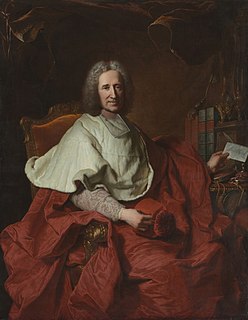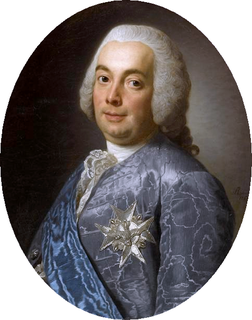The Secretary of State was the name of several official governmental positions – supervising war, foreign affairs, the navy, the king's household, the clergy, Paris, and Protestant affairs – during the Ancien Régime in France, roughly equivalent to the positions of governmental ministers today. The positions were created in 1547, but gained in importance only after 1588. The various secretaries of state were considered part of the Great Officers of the Crown of France.

The Ancien Régime was the political and social system of the Kingdom of France from the Late Middle Ages until 1789, when hereditary monarchy and the feudal system of French nobility were abolished by the French Revolution. The Ancien Régime was ruled by the late Valois and Bourbon dynasties. The term is occasionally used to refer to the similar feudal systems of the time elsewhere in Europe. The administrative and social structures of the Ancien Régime were the result of years of state-building, legislative acts, internal conflicts, and civil wars, but they remained and the Valois Dynasty's attempts at re-establishing control over the scattered political centres of the country were hindered by the Huguenot Wars. Much of the reigns of Henry IV and Louis XIII and the early years of Louis XIV were focused on administrative centralization. Despite, however, the notion of "absolute monarchy" and the efforts by the kings to create a centralized state, the Kingdom of France retained its irregularities: authority regularly overlapped and nobles struggled to retain autonomy.

France, officially the French Republic, is a country whose territory consists of metropolitan France in Western Europe and several overseas regions and territories. The metropolitan area of France extends from the Mediterranean Sea to the English Channel and the North Sea, and from the Rhine to the Atlantic Ocean. It is bordered by Belgium, Luxembourg and Germany to the northeast, Switzerland and Italy to the east, and Andorra and Spain to the south. The overseas territories include French Guiana in South America and several islands in the Atlantic, Pacific and Indian oceans. The country's 18 integral regions span a combined area of 643,801 square kilometres (248,573 sq mi) and a total population of 67.3 million. France, a sovereign state, is a unitary semi-presidential republic with its capital in Paris, the country's largest city and main cultural and commercial centre. Other major urban areas include Lyon, Marseille, Toulouse, Bordeaux, Lille and Nice.

The Great Officers of the Crown of France were the most important officers of state in the French royal court during the Ancien Régime and Bourbon Restoration. They were appointed by the King of France, with all but the Grand Chancellor of France being appointments for life. These positions were not transmissible nor hereditary.







